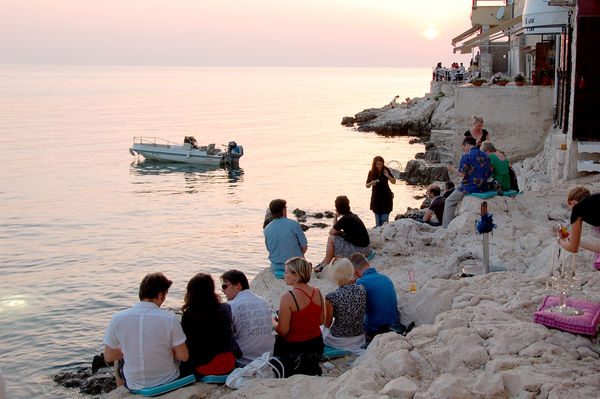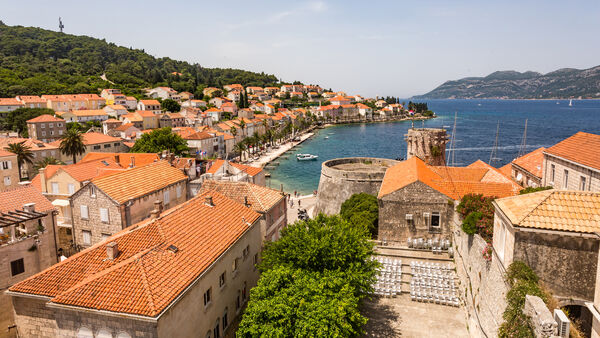Croatia’s Coastal Delights
By Rick Steves


I love the knack Croatians have for taking a humble stretch of craggy shoreline and turning it into a wildly romantic bar or café. In the coastal town of Rovinj, several bars and restaurants offer tables atop the town's rocky seawall, and some provide you with a pillow — an invitation to find your own nook in the rocks overlooking the bay. As the sunset fades and the flames from tealight candles seem to brighten, you realize just how easy it is to enjoy a luxurious moment on the Adriatic coast.
The eastern shores of the Adriatic Sea benefit from the Adriatic's counterclockwise prevailing current, which moves clear, warmer water from the central Mediterranean up along the coastline of Croatia. And the craggy geology of the Dinaric Alps, which jut right up against Croatia's coast, mean that this stretch is sprinkled with islands. Not surprisingly, these shores have long been a popular destination for Slavic Europe. Sometimes it's difficult to distinguish this lively-but-easygoing area from Italy.
That's especially true in the northern peninsula of Istria, which borders Italy and where both Italian and Croatian are spoken on a daily basis. Instead of the sheer limestone cliffs found along the rest of the Croatian shoreline, the Istrian coast has gentle green slopes, giving it a more serene feel. Though Istria has its share of tacky touristy beach towns, it also hosts my favorite Adriatic town, Rovinj.
Surrounded by the sea on three sides, Rovinj is like a little hunk of Venice draped over a hill. It's simply romantic. Boats laden with kitschy shells for sale rock giddily in the harbor. The fountain on the main square celebrates the arrival of the water system in 1959. A bell tower with a rickety staircase requires an enduring faith in the strength of wood. From the top a patron-saint weather vane boldly faces each menacing cloud front that blows in from the sea.
If you visit, walk through its market to peruse the fresh offerings: figs, cherries, grapes, olive oils, honey, and more. Women push grappa, homemade fruit brandies, and curiously flavorful walnut samples on shoppers. The fish market at the back is where locals gather ingredients for their favorite dish, brodet — a stew of various kinds of seafood mixed with olive oil and wine.
Though Istria has become something of a hot spot, it's still not as famous as its southern rival, the Dalmatian coast, home to Croatia's top tourist town, Dubrovnik. Its most remarkable feature is the mighty wall that's surrounded the city for centuries, and walking along its ramparts — which offer unforgettably scenic views across a landscape of tiled rooftops, down into narrow cobbled lanes, and out to the blue Adriatic Sea — is its single best activity.
Sun worshippers can easily find a pebbly patch along one of Dubrovnik's beaches, but to truly appreciate the coast, it's best to head out to one of the islands. My two favorites are Korčula, with its "mini-Dubrovnik" vibe, and Hvar, a largely sleepy isle but for the chic crowds that converge in its main town to see and be seen.
That main town, also named Hvar, has become a big draw for celebrities and yachters, making it one of the most expensive places to stay in Croatia. But aside from the nightlife scene, activities there are low energy. The main square is a relaxing people zone surrounded by inviting cafés filled with deliriously sun-baked tourists. The formidable fortress hovering above town rewards hikers with stunning views. At the Benedictine convent, sisters make lace using fibers from the cactus-like agave plant. Some yellowed samples of their work date from the late 19th century.
Beyond town lies a dramatically mountainous landscape that's been carefully worked over the centuries to produce deservedly famous wines and, more recently, lavender.
Korčula, on the other hand, is generally ignored by the jet set. There's no "scene" here — just an atmospheric medieval town filling a small peninsula on one of Croatia's most beautiful islands.
Like some other Croatian coastal towns, Korčula was founded by the ancient Greeks. It became part of the Roman Empire and was eventually a key southern outpost of the Venetian Republic.
Korčula has two parts: the functional side — where most people park, eat, and sleep — and the time-warp Old Town. The Old Town's historic gate is a reminder that Korčula was once a mighty little place. Facades recall its 14th-century trading heyday, each one contributing to the evocative medieval townscape and dripping with drying laundry and local character.
Every Thursday in summer, lazy Korčula snaps to life when locals perform a medieval folk dance called the "Moreška." Staged at an outdoor theater, the Moreška helps Korčulans remember their hard-fought past: A bad king takes the good king's bride, the dancing forces of good and evil battle, and a happy ending follows.
When visiting the Dalmatian coast, seafood is a must, as hardworking restaurants seem to abide by the local creed: Eating meat is food; eating fish, that's pleasure. One waiter reminds me that a fish should swim three times: first in the sea, then in olive oil, and finally in wine. Red wines, which Croatians actually call "black wine" (crno vino), are a specialty along the southern coast.
With succulent seafood, sunny beaches, and a carefree attitude, Croatia's coast offers Slavic Europe's own twist on la dolce vita.

